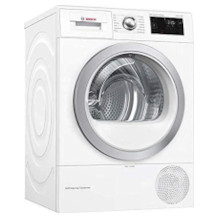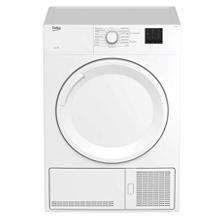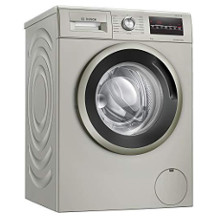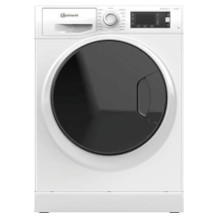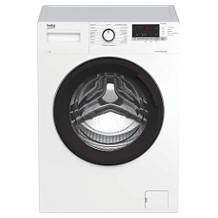Washing machine purchasing advice: how to choose the right product
- What you need to know
- There are two main types of washing machine designs: front-loading and top-loading. Front loaders are the most common type you find in homes.
- Having the right capacity washing machine will help you save water and electricity.
- AquaStop and a child lock are two essential features you should have on any washing machine.
- Regular cleaning and descaling is neither difficult nor time-consuming, and will considerably extend the lifetime of a washing machine.
A household essential
Whether you live alone, with friends, a partner, or with your family, a washing machine is one of the most essential home appliances. It wasn’t always like this though – hand washing was the primary method for most people for a long time. The first patent for a washing machine was registered by the British inventor John Tyzacke in 1691, but it took quite a while for washing machines to really take hold. The first electric machines were manufactured in New York and Chicago from about 1907, but they really began to conquer private households in the USA after the Second World War. By the 1960s and 70s, these appliances had become affordable enough for most of the US population.
However, this isn’t to say that washing machines are in every home worldwide. In fact, only about 30% of people worldwide have access to a washing machine. This figure is of course different depending on where you are in the world. For example, in Germany, 96.4% of private households have a washing machine, making it the second most popular home appliance after refrigerators.
If you can afford to buy your own washing machine, the advantages are huge compared to using a laundromat:
- No travel to the laundromat
- No waiting in the laundromat
- Price per wash is much higher at the laundromat
- No need to transport your laundry
Types of washing machines
There are essentially two main types of washing machines: front-loading and top-loading. These differ in terms of where you put your laundry in. As you can probably guess, front-loading machines have a door on the front, top-loading machines have it on the top. Both styles have their own respective advantages and disadvantages, depending on where you are planning on installing them.
Front-loading washing machines
Front loaders are by far the most popular type of washing machine, with a market share of around 90%. If you have enough space, a front-loading machine is the way to go. The reason for this is that this style of washing machine offers many advantages compared to top loaders. Moreover, due to their popularity, the number of models to choose from is far greater.
These washing machines tend to have a larger capacity than top-loading machines, and also run more quietly due to their wider dimensions. In general, capacity ranges from 1.4 to 2.2 cubic feet (6-9kg). Most models have a wide selection of different wash programs, and their top plates can either be used as storage surfaces, or they can fit under kitchen counters. You can get integrated machines with a removable top plate, which can be built into your kitchen cabinets.
Can all front-loading machines be inbuilt?
The short answer is no. Usually, manufacturers will indicate if their machine can be inbuilt, which means they will have a removable top panel which can be replaced by a kitchen surface.
There are a few disadvantages to front loaders compared with top-loading machines. Once you’ve started a cycle, you won’t be able to open the door and add more laundry as water would leak out – top-loading machines don’t run into this problem. To load and unload the machine, you’ll need to bend down or get on your knees, which might be an issue. Furthermore, since the detergent and water is in constant contact with the rubber seal on the door during a cycle, front loaders are more prone to leaking than top loaders. In spite of these small disadvantages, front-loading machines remain a solid and popular option, not least because well-equipped models can be relatively inexpensive. Prices tend to range from $250 to over $2500.
Advantages
- Fits under kitchen surfaces
- Relatively large capacity
- Multiple washing programs
- Quiet
- Stable
- Top surface can be used as a shelf
- Wide choice of models
Disadvantages
- Wide
- You need to bend down to load them
- Cycle cannot be interrupted
- Rubber seal more susceptible to damage
Top-loading washing machines
Overall, top-loading washing machines have more disadvantages than advantages. This said, in certain situations they are a better option than front loaders. They are significantly narrower, which can make them the best option if you have space limitations. Likewise, if you prefer not to bend down to fill up the washing machine, a top loader might be a better choice. The fact that the rubber seal is on the top and not constantly in contact with water also means that top loaders are relatively unlikely to leak.
If you’ve ever turned on your washing machine and realized you’ve forgotten a couple of socks, you’ll be pleased to know that top-loading machines let you stop the cycle midway to add them in. The washing drum rotates vertically in top loaders, which means they are less likely to fall over.
Despite their specific advantages, top-loading machines do have a few distinct disadvantages compared to front-loading ones. They aren’t particularly stable due to their thin dimensions, which also results in more noise during spin cycles. Capacity is usually between 1.1 and 1.7 cubic feet (4.5-7kg), which is far less than front loaders. They can’t be integrated underneath kitchen cabinets, since the countertop would block the opening – you’ll need to leave at least a foot (40cm) of space free above the machine. For the same reason, you also won’t be able to use the top as a storage space. Since only about 10% of washing machines sold are top-loading, there aren’t that many options available on the market. Prices start at around $350, and can run up to around $1400.
Advantages
- Narrow
- Can be loaded standing up
- Leak-proof
- Can be loaded during a cycle
- Durable
Disadvantages
- Cannot be integrated under kitchen surfaces
- Comparatively low capacity
- Less stable
- Fewer cleaning programs
- Top needs to remain free
- Less products on the market
- No viewing window
- Comparatively expensive
Washer-dryers
While you can get front-loading machines that let you put a tumble dryer on top of them, an alternative option is to get a combination washer-dryer. Visually, these machines look just like front loaders, but they can also dry your clothes. While these are a great space-saving option, they aren’t as good as standalone devices at either washing or drying. You also won’t be able to simultaneously wash and dry two loads of laundry.
Advantages
- Space-saving
- No need to move laundry from washer to dryer
- Cheaper than two standalone machines
Disadvantages
- Washing and drying not possible simultaneously
- High energy consumption
- Lower loading capacity for drying than washing
- Drying takes longer than in a normal tumble dryer
Capacity
Once you’ve chosen the style of washing machine you want, the next thing to think about is capacity. Manufacturers specify capacity in cubic feet in the US, while in Europe it is rated in kilograms.
Why is the choice of the appropriate nominal capacity relevant?
Clearly, the larger the capacity, the more laundry you can do in one cycle. If you have too much capacity, you’ll end up using excess electricity and water by not filling your washing machine completely.
A full machine saves money!
Tests have shown that front-loading machines consume almost three times as much electricity when they are only slightly full compared to when they are totally full, so always fill your washing machine fully!
If you don’t have enough capacity, you’ll have to run multiple washes, which also will end up costing more. If you overload your machine, you run the risk of damaging it permanently, so it’s not worth running the risk.
How to choose the right capacity
Top-loading machines generally have a capacity between 1.1 and 1.7 cubic feet (4.5-7kg), while front-loading machines tend to have between 1.4 to 2.2 cubic feet (6-9kg). This se aid, there are of course models on the market with smaller and larger capacities than this.
The right size washing machine entirely depends on the size and type of your household. For example, a family will usually benefit from a larger machine as there will be a lot of laundry combined from everyone, but a house share with the same number of people as the family might actually benefit from a smaller machine as everyone will be doing their washing separately.
The questions you need to ask yourself to determine what capacity you need are as follows:
- How many people will be doing their laundry at the same time?
- How often do people do their laundry?
- Do some people have a lot of laundry due to professional or recreational reasons?
- Do you plan on washing large textiles like curtains and bed covers frequently?
As you might have guessed, there aren’t any hard and fast rules when it comes to choosing the right washing machine capacity. In spite of this, the following table gives a rough guide of what you might need:
| Nominal capacity | Household size in persons | Typically suitable for … |
| 1.2 ft³ (5 kg) | 1 or 2 | Single household, couples with low laundry load |
| 1.4 ft³ (6kg) | 2 or 3 | Average household |
| 1.7 ft³ (7kg) | 3 or 4 | High-volume family |
| 2 ft³ (8kg) | 4 or 5 | Larger family with high laundry volume |
| 2.2 ft³ (9kg) | More than 5 | Large families |
The most important features
All washing machines work in the same way: you fill them up with clothes, detergent, and sometimes fabric softener, select a program, and press start. This said, there are a few extra features that can differentiate one model from the next. Read on for an overview.
Automatic load control and load sensor
This feature helps you save water and energy by automatically adjusting the amount of water the cycle uses depending on the size of the laundry load. So, if you put less laundry in the machine, it will use less water. Load sensors usually display the weight of your laundry on a little screen, which lets you know if you should add anything else to the drum. Some models will also display how much detergent you need dependent on the load.
Start time preselection and remaining time display
Start time preselection is an extremely useful feature if you aren’t always home. It lets you choose when you want the cycle to start or end, which means you can set your washing to be done when you get home. The remaining time display lets you know how long is left for the cycle.
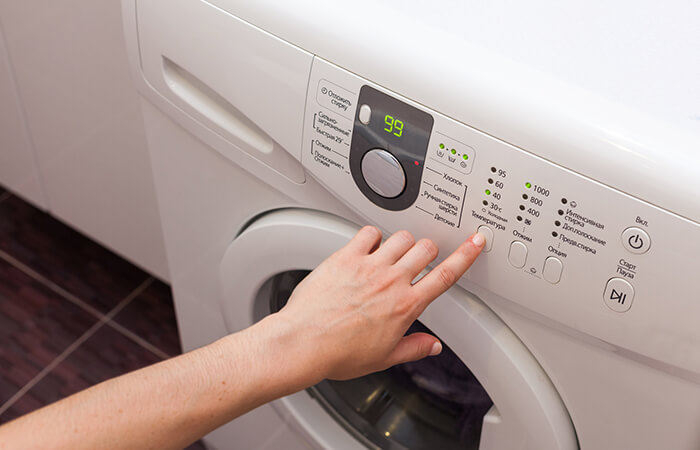
Aquasensor
Aquasensors automatically optimize and adjust the washing cycle by calculating how dirty the waste water is. If your laundry is still dirty, the machine will automatically increase the number of rinse cycles.
Unbalance control
This is now a standard feature on all washing machines. If you wet laundry is unevenly distributed in the drum, it can damage the bearings in the machine and cause it to wobble around. Machines with unbalance control negate this by distributing your laundry evenly at the start of the cycle by slowly spinning the drum.
AquaStop and multiple water protection
This feature is worth its weight in gold if your inlet hose ever leaks or breaks. Aquastop is a protective system on the water supply hose. If the pressure drops in the hose, it automatically shuts off the water supply to prevent further damage.
Multiple water protection activates if your washing machine is leaking. It senses if the water level is rising in the base tub, and will stop the water supply and pump out any excess if this happens.
Child lock
Washing machines can be fascinating for small children. For this reason, it’s important to have a child lock to prevent your kids from interrupting the cycle or changing the washing program. Most models have a separate button to activate the child lock.
Cleaning and maintenance
Cleaning and maintaining your washing machine is much easier than it used to be. Nowadays, if you do a few things regularly, your machine will last for a long time.
Cleaning the rubber seal
Over time, limescale, dirt, and mold can build up on your washing machine’s rubber seal, particularly on front loaders. It’s a good idea to wipe the seal down with a damp cloth after each cycle to prevent anything from building up. Don’t use chemical detergents to do this, as they can damage the rubber and make it brittle, which can lead to leaks.
After each wash, it’s a good idea to leave the door of your washing machine open. This will allow the inner drum to dry without any bad odors trapped inside.
Cleaning the detergent drawer
Over time, residue will build up in the detergent drawer. This can lead to the formation of bacteria, which can cause bad odors and mold. It’s a good idea to clean the drawer every few months to prevent this from happening. If the residue is particularly stubborn, you can use vinegar to get rid of it. Some models have completely removable drawers which you can put in your dishwasher or soak in a bucket of warm water.
Cleaning the lint filter
If your lint filter gets clogged, it can cause some pretty bad odors in your machine and on your laundry. Larger objects like lighters coins can also cause your machine to clog, which will mean it won’t be able to fully drain.
If your filter is clogged, you’ll need to open it at the base of your washing machine. This will let any excess water drain out, so make sure to have a container nearby. You can clean the filter with some lukewarm water. It’s a good idea to do this every six months or so.
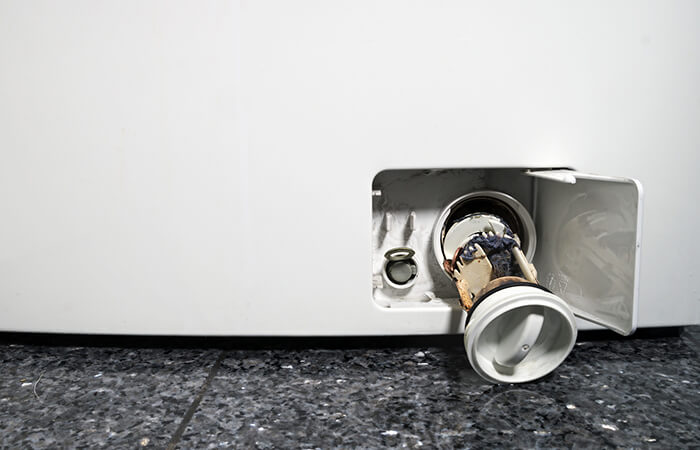
High temperature cycle
Most washing machines work at low temperatures nowadays, in an effort to save electricity. Most detergents work well at low temperatures, but sometimes you should run a hot wash to dissolve any residual suds left in your machine. This will minimize any bad odors and prolong the lifespan of your washing machine.
Descaling the machine
Depending on the hardness of the water, it may be necessary to descale the machine at regular intervals using descaler, vinegar, or citric acid.
Descaling is worth it
If your machine is full of limescale, it will consume up to 30% more electricity per cycle. It can also damage the internal electrics and cause your laundry to not get properly cleaned as the heating elements won’t be able to heat the water enough.
Descaling your washing machine is simple:
- Put descaler in the detergent compartment or in a ball in the machine
- Set the highest temperature
- Start wash cycle without laundry
- Stop the machine during the process or set it to “soak”.
- Finish the wash cycle normally
Usage tips
Once you’ve got your new washing machine installed, there are a few things you should know to help you use it properly. Read on for some useful tips.
Which washing program is suitable for what?
Control panels of modern washing machines usually have several buttons or a rotary switch that you use to select the washing program. The programs usually differ according to the type of textile or the washing temperature. In addition, there are other buttons or switches for various additional functions, such as quick wash programs, prewashes, or additional rinses. The range of possibilities and combination options is constantly expanding.
There are now also lots of special wash cycles on modern washing machines, such as a separate program for pet hair removal. Most models also have other buttons for selecting things like spin speed, temperature, and start time. Models with a display will show the details of the program such as temperature or cycle time.
Washing machine displays should provide the following information:
- Time remaining
- Start time display
- Indication of current program
- Status of the child lock
- Display at the end of the program

Standard programs
Standard programs usually consist of a combination of fabric type, color, or eco-wash cycle with the desired wash temperature. For example, you often find things like a 104 °F (40 °C) cotton cycle, boil wash/color wash, easy-care laundry and, wool. With these combinations, modern washing machines can thus quickly come up with up to 20 standard programs.
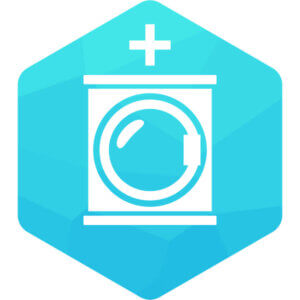
Special programs
Special programs are a bit different to the standard programs. They are tailored to certain fabrics or degrees of soiling, such as dark textiles, lightly soiled cotton laundry, or baby clothes. For particularly delicate items, for example, you can get a “hand wash” program or the so-called “mix” programs (for mixed fabrics of cotton and synthetics).
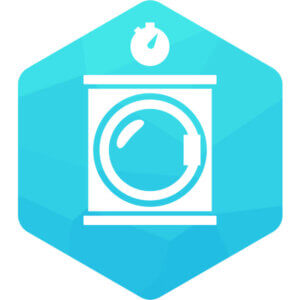
Quick programs
These programs are designed for quickly washing small quantities of lightly soiled textiles. The washing time is usually less than 30 minutes and the maximum washing temperature is 86 °F (30 °C).
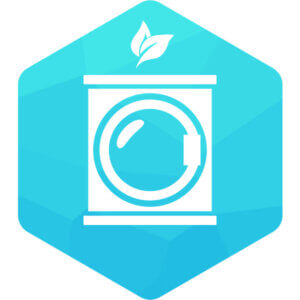
Eco programs
Eco programs are very important at the moment. Compared to standard programs, these cycles save energy and water. As with standard programs, the more the machine is filled to capacity, the greater the saving. Eco programs take longer than standard wash cycles because they work at lower temperatures and instead allow the laundry to soak in the water for longer.
What detergents are there and what are they suitable for?
There are normally three separate detergent compartments depending on what kind of laundry you are doing. In front loaders, these are in a drawer on the front, in top loaders on the inside of the flap. What compartment you use depends on whether you are using a heavy-duty detergent, a detergent for colors, a mild detergent, or a fabric softener.

Heavy-duty detergents
These are suitable for almost all types of laundry at all washing temperatures. However, as heavy-duty detergents contain bleaching agents and optical brighteners, they should not be used on sensitive, colored textiles. Heavy-duty detergents are ideal for white and heavily soiled textiles at washing temperatures of 85 to 200 °F (30-95 °C).

Color detergents
If you’re washing colors at temperatures between 70 and 140 °F (20-60 °C), a special color detergent will be your best option. These detergents prevent discoloration but cannot guarantee complete color retention.

Delicate detergent
These detergents are suitable for delicate fabrics being washed at 85 °F (30 °C). Silk, wool, functional textiles, fine tights, and textiles made of cellulose fibers (such as lyocell and viscose) always require mild detergents.

Fabric softeners
Fabric softeners are now an essential part of many people’s laundry cycles. They prevent clothes from drying out, making them softer and easier to iron. In most cases, these additives also give your laundry a more discreet scent. In synthetic fabrics, fabric softener reduces the electrostatic charge between the fibers. It is not advisable to use fabric softeners when washing towels or tea towels. They lose their water absorption capacity due to the fabric softener, which protects the fibers.
What do the washing instructions on yourclothes mean?
Before washing new clothes, the question often arises: what care does this particular textile require? In order to protect the color and structure of the fabric as much as possible during cleaning, it is advisable to use the washing symbols as a guide. These are standardized across Europe, Israel, the USA, and Japan.
The five washing symbols are usually found (always in the same order) on a white patch in the left inner seam. The following sequence and symbols apply:
- Washing bowl: washing
- Triangle: bleach
- Square: drying
- Iron: ironing
- Circle: dry cleaning
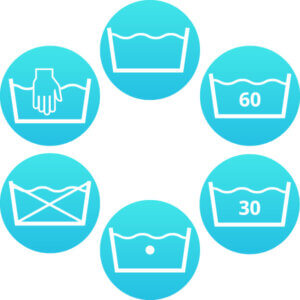
Washing
The number in the laundry basket indicates the maximum washing temperature. Here, “30°” means that the laundry should be washed at a maximum of 30 degrees Celsius (85 °F). There is an alternative notation where dots are used: one point corresponds to 30 °C (85 °F), two points to 60 °C (140 °F), and three points to 90 °C (195 °F). The maximum number of spins is possible if there is no horizontal line under the laundry basket symbol. One dash means spin gently and two dashes indicate no spin. A hand in the water shows that the textile should be hand washed, and if the symbol is crossed out, it unfortunately means only one thing left to do: do not wash! Only dry cleaning can help here.

Bleach
This washing symbol, a triangle, is always in second place. An empty triangle means you can bleach the fabric. If there are two parallel lines through it, only bleaching with oxygen is allowed. If it is crossed out, the textile must not be bleached.

Drying
A square with a circle inside indicates that the garment can be dried in a tumble dryer. One dot indicates gentle drying, two dots indicate very gentle drying and three dots indicate extremely gentle drying. A crossed-out symbol means do not use a dryer!
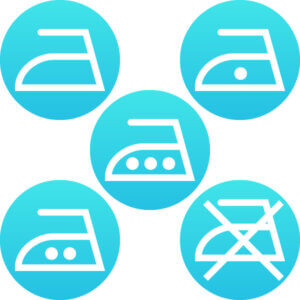
Ironing
This symbol is relatively self-explanatory. Crossed out means ironing is prohibited. One dot allows ironing at a maximum of 230 °F (110 °C). Two dots draw the temperature limit at 300 °F (150 °C) and three dots at 390 °F (200 °C).

Dry cleaning
A circle indicates that the fabric should be dry cleaned. If the circle is crossed out, it means it should not be cleaned. If there is an F inside the circle, it means it should be cleaned with hydrocarbons. P indicates for the use of the solvent perchloroethylene, and W refers to wet cleaning. One or two horizontal lines under the cleaning symbol indicate gentle or very gentle cleaning.
Image 1: © brizmaker / stock.adobe.com | Image 2: © jozsitoeroe / stock.adobe.com | Images 3-15: © FinalCheck

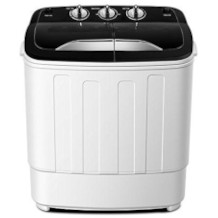
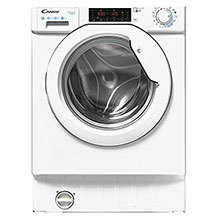
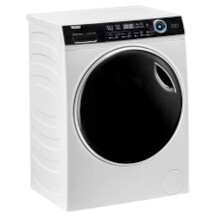
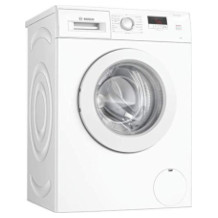
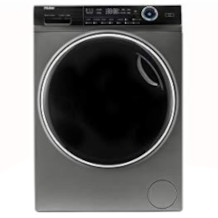
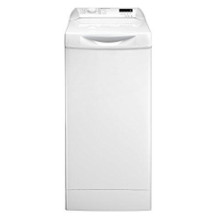
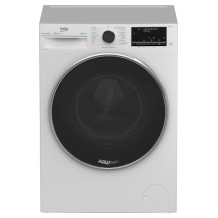
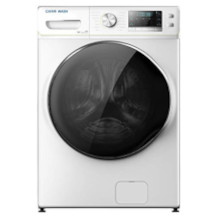

 99 reviews
99 reviews
